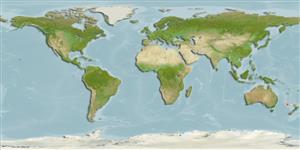Klassifizierung / Names
Namen | Synonyme | Catalog of Fishes(Gattung, Arten) | ITIS | CoL | WoRMS | Cloffa
>
Gadiformes (Cods) >
Macrouridae (Grenadiers or rattails)
Etymology: Coelorinchus: Greek, koilos = a hollow + Greek, rhyngchos = jaw (Ref. 45335).
Environment: milieu / climate zone / depth range / distribution range
Ökologie
seewasser bathydemersal; tiefenbereich 906 - 1142 m (Ref. 26363). Deep-water; 34°S - 36°S
Southwest Pacific: endemic to New Zealand.
Size / Gewicht / Alter
Maturity: Lm ? range ? - ? cm
Max length : 35.0 cm TL Männchen/unbestimmt; (Ref. 26363)
Kurzbeschreibung
Morphologie | Morphometrie
Rückenflossenstacheln (insgesamt): 2. Two dark bands on the body, running from dorsal to ventral surface; the first broad, dark blue (brownish near margins), starting anteriorly at first dorsal fin origin on dorsal surface and isthmus on ventral surface; ending posteriorly at about the fourth ray of second dorsal fin, ventrally at about sixth ray of anal fin; second band smaller, about one-third width of first, paler brownish blue and situated close to midpoint of body; a dark, thin rim of pigmentation around orbit; ventral surface of head and lower jaw naked, except for scutes on anterolateral edges of snout; snout moderate in length, 37.9-41.3% HL (Ref. 26363).
Rarely encountered (Ref. 26363).
Life cycle and mating behavior
Geschlechtsreife | Fortpflanzung | Ablaichen | Eier | Fecundity | Larven
McMillan, P.J. and C.D. Paulin, 1993. Description of nine new species of rattails of the genus Caelorinchus (Pisces, Macrouridae) from New Zealand. Copeia 1993(3):819-840. (Ref. 26363)
IUCN Rote Liste Status (Ref. 130435)
Bedrohung für Menschen
Harmless
Nutzung durch Menschen
Mehr Information
NamenSynonymeMetabolismusRäuberÖkotoxikologieFortpflanzungGeschlechtsreifeAblaichenSpawning aggregationFecundityEierEientwicklung
Alter/GrößeWachstumLänge-GewichtLänge-LängeLängenhäufigkeitenMorphometrieMorphologieLarvenLarven Pop.Dyn.RekrutierungDichteBRUVS
ReferenzenAquakulturAquakultur ProfilZuchtlinienGenetikElectrophoresesVererbbarkeitKrankheitenVerarbeitungNutrientsMass conversion
PartnerBilderStamps, Coins Misc.LauteCiguateraGeschwindigkeitSchwimmstilKiemenoberflächeOtolithsGehirngrößeSehfähigkeit
Tools
Zusatzinformationen
Download XML
Internet Quellen
Estimates based on models
Preferred temperature (Ref.
123201): 3.1 - 4.4, mean 3.9 °C (based on 24 cells).
Phylogenetic diversity index (Ref.
82804): PD
50 = 0.5000 [Uniqueness, from 0.5 = low to 2.0 = high].
Bayesian length-weight: a=0.00575 (0.00195 - 0.01700), b=3.08 (2.83 - 3.33), in cm total length, based on LWR estimates for this (Sub)family-body shape (Ref.
93245).
Trophic level (Ref.
69278): 3.5 ±0.5 se; based on size and trophs of closest relatives
Widerstandsfähigkeit (Ref.
120179): niedrig, Verdopplung der Population dauert 4,5 - 14 Jahre. (Preliminary K or Fecundity.).
Fishing Vulnerability (Ref.
59153): Low vulnerability (25 of 100).
